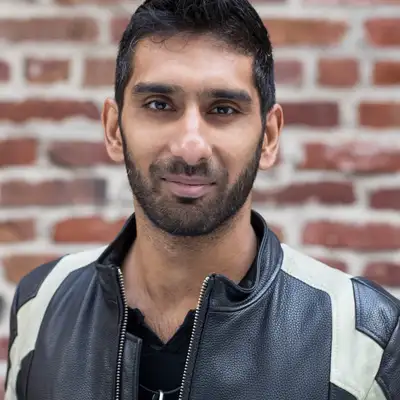Episode 33 Inside Superhuman's Quest for Email Perfection
Download MP3Hessie Jones
Hi everyone. I'm Hessie Jones and welcome back to Tech Uncensored. We are here at collision and I'm happy to have with me Rahul Vora, CEO of superhuman.
Rahul Vora
Thank you for having me.
Hessie Jones
Perfect. So, I'm happy to actually speak to you. You've been on my mind for the last couple of years because of the incredible work that you've done. Tell me a little bit about your journey to superhuman. Like, what is it and what are you trying to solve?
Rahul Vora
So superhuman is the fastest e-mail experience in the world. Our customers get to their inbox about twice as fast as before. They can reply to that important message sooner, and many of them see Inbox Zero for the first time in years, saving 3 to 4 hours a week. So, it really rethinks the whole e-mail experience in terms of how we got here. This was really after I sold my last company reported to LinkedIn and LinkedIn, as you know, is in Sunnyvale. I was living in San Francisco at the time, and I was commuting from work back to the city and that's a one-hour drive. This was in the heyday of Uber and Lyft. I was actually in the back of an Uber and in that car ride, I was able to clear my e-mail, write some documents for the next day, look at my calendar, get a really nice dinner reservation for me and my girlfriend, and even called my mum. I was a productive employee; I was a proactive boyfriend; I was a present son. I was his generally a better human. So, I realized that the magic of Uber wasn't about transportation. It wasn't getting from A to B. It was really about time. When I was ready to think about, OK, what is my next startup idea? I looked at everything through the lens of time and it turns out, and this is probably no surprise. We spend a tremendous amount of time on e-mail that despite Microsoft Teams, the 1 billion professionals that there are in the world, we still spend on average 3 hours a day on e-mail. That's a trillion hours every single year. So, what if founders talk about finding a big problem or looking for impact and this was literally the biggest thing that I could think of, and it was like sitting right there under my nose.
Hessie Jones
That's interesting. I mean, I don't know whether we're ever going to solve the mail problem. As long as people are going to communicate, send messages, you're always going to be in business.
Rahul Vora
Right.
Hessie Jones
Let’s go back to when you started to build superhuman and one of the things that we had talked about earlier is a post that I saw on Twitter about your quest for product market fit and how difficult it was earlier on. Can you tell us a little bit about that?
Rahul Vora
Sure. I think it's first helpful to maybe just contextualize products market fits a little bit. It's the number one reason why startups succeed and the lack of it is the number one reason why startups fail. In the journey of superhuman, I felt this intense, incredible pressure to launch as my last company had launched, scaled and been acquired in less than two years and we were two years into superhuman, and we still hadn't launched. But I knew that no matter how intensely I felt, the pressure that a launch would go very badly. But I couldn't just say that to the team like these are super ambitious, hyper intelligent engineers. They'd put their hearts and souls into the product, so I needed a plan. I searched for the Holy Grail. I spoke to all the experts read everything I could find and what I found was a way to define product-market fit, a metric to measure product, market fit and even a methodology to systematically increase product market fit which I know sounds crazy. Like how you can put an algorithm on this but actually you can, and we applied it very successfully at superhuman. We got this metric from did not have product market fit at all to have a lot of products market fit over the course of three or four quarters. And then I've written this up, so it's called the superhuman products market Fit engine and it's on first round review. It's now the most shared article in that publication. It's the standard way that startups measure products, market fit, and it's helped hundreds of companies since then, so I would highly recommend folks check it out.
Hessie Jones
Perfect. Thank you. This has been, I think, a major lesson for you actually in developing your company. And so how are you using it to actually help fuel other startups' growth?
Rahul Vora
So, it's most useful at the start of a product where you have very little feedback, where you have maybe confusing feedback because you have all different kinds of people, and you need to segment them, and you need to make sense of it. Once the product is a little bit more mature and we're eight years into superhuman, that specific framework becomes a little less relevant. However, we're always creating new features of superhuman. We're always thinking about new products. And as you know, I also Angel invests. So, when I look at these new companies, it's actually a very helpful lens, a very helpful filter; to see how people react to those products.
Hessie Jones
Thank you so much. OK. So, let's talk about generative AI, because I feel like all my conversations these last three days have been about generative AI. You said something really interesting. We're on the cusp of a huge transformation in terms of how I would measure this. This is without exaggeration. On par with a smartphone and the Internet itself, we're going to see everything change. So, tell us about why you said this and how it's actually impacting the things that you're building today as superhuman.
Rahul Vora
So, the reason why I said that is every single experience that you use today, whether it's a consumer experience or a work experience, imagine all the productivity software, all the collaboration software that you use is in the process already of integrating generative AI and it's going to. Unlock things that maybe feel a little bit like science fiction today. So, because these people say generative AI, I specifically mean large language models as the technology that's going to transform how we work. Because they can understand the nuances of natural language, in many cases better than we ourselves can. So much of how we used to work, I think is going to change going forward. So, take my company superhuman, we build the world's fastest e-mail client. We've already started rolling out superhuman AI to our user base. With this you can now write, edit, research, you can translate, summarize. You can literally go from a few ideas about an e-mail that you want to write to a fully formed, fully written e-mail that's actually written in your tone in your voice and ready to send.
Hessie Jones
In your tone and in your voice.
Rahul Vora
Correct. Yes, absolutely.
Hessie Jones
OK. All right.
Rahul Vora
So again, it feels like science fiction, but when you see it working, you're like, wow, that really does have the potential to change everything here. I should add that we're in the earliest days. Remember, this technology has only been what I would call tech popular, meaning all the companies have been integrating it since perhaps early this year. So, we're only four months into this journey. Obviously large language models have been worked on for much longer than that, but in terms of their integration into the fabric of our software, we're in the earliest days. So, by the end of this year, things are going to look very different.
Hessie Jones
OK. So, one last question, you have an Angel fund, you alluded to it earlier, you've invested more than 35 million in more than 100 companies. Tell us about that. What is your thesis and why are you doing this?
Rahul Vora
I guess there's two parts to the thesis. One is in growing superhuman and in scaling and selling my previous company, I feel like I have a lot of hard-won battle scars, operational lessons, maybe insights. I certainly feel like I understand a lot about how to build products that people love. I would like to give that back and actually help the next generation of founders, hopefully maybe avoid some of the mistakes that I made earlier in my career. I also do this investing with a very good friend of mine, Todd Goldberg, and we have an interesting setup for the fund. I'm a full-time founder, full time operator of running superhuman is way more than a full-time job, but Todd, who is the other GP in the fund and he's way more than full time investor. We have that kind of barbell balanced approach to the fund where on the one hand you've got Todd on speed dial any minute of every hour of every day and then on the other hand, you have me and I'm a little bit less available, but I'm also fully up to speed with how companies are being operated today in operating a scaled company that myself. So that's one part of the thesis is giving back. The other part is it keeps me smart; it keeps me connected. One of the take generative AI as an example, since we just talked about it, one of the most inspirational things is seeing what kind of companies, features, products and ideas the next generation of founders are working on because then that just gets your brain going, it keeps you inspired, keeps you optimistic about the future of technology, and I think it just helps us all create better businesses.
Hessie Jones
That's amazing. OK, that's it. That's all I have for today. And I thank you so much. For joining me. I look forward to the next iteration of superhuman and the amount of productivity you're actually going to instill in the world. Thank you for joining me. Thank you.
Creators and Guests


